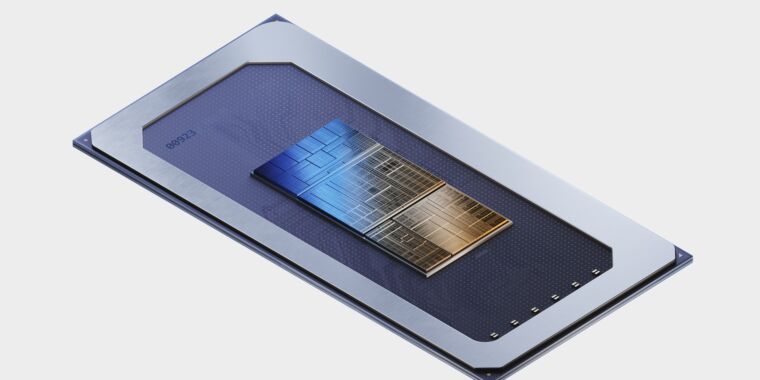Intel doesn’t think that Arm CPUs will make a dent in the laptop market::“They’ve been relegated to pretty insignificant roles in the PC business.”
Nobody tell Intel about Apple Silicon! Or that Apple’s sales are increasing while they rest of the industry is in a slump.
Apple’s laptop segments have been decreasing massively since their switch to custom chips, actually. Could just be timing, or could be that people don’t want the hassle.
https://www.macrumors.com/2023/10/18/kuo-macbook-sales-down-amid-no-new-products/
Probably becuase people bought new Mac’s in 2020 and don’t feel like upgrading.
https://www.macrumors.com/2020/10/30/apple-says-strong-mac-sales-led-by-macbook-pro/
They swapped to M series chips, what, two years ago? This says sales this year are down due to no new Macs.
Hassle?
Not everything runs on MacOS with Arm. Some people may not upgrade to M* class chips, and others who may have switched don’t want the hassle. I know plenty of developers who went to ThinkPads on Linux instead upgrading to M* architecture and having build issues.
Plenty of developers? Ok, sure. It was rocky for less than a year after they released the M1’s. I barely had any issues on my M1 Max that I got at release and I was just thinking the other day about how in haven’t thought about “will this run” or “oh there’s that thing that doesn’t run” in forever.
Yeah, it really hasn’t been a hassle. At my workplace (software research, lots of which is actually x86-specific) many people have switched to Apple silicon Macs and nobody is looking back. The only issue I’ve noticed that is disruptive in any way is that Apple isn’t really supporting TAP based network adapters which causes trouble once in a while, mostly with certain vpn configurations. Standard development tools like IDEs, compilers, etc have worked since nearly day 1. Basically the only common targets that I wouldn’t develop for is Windows, but even then you can do it in a VM and it’s the fastest way to run windows on ARM still.
There’s a lot of brew packages that messed up when the chips came out. It’s still a bit of an issue two years later.
The M1 series was super good and Apple just hasn’t released anything since then worth upgrading to if you have an M1. They’re gaining market share though slowly, which indicates that their sales slump is lower than the market average.
Their selling points for the previous generation are now moot though, so that’s why people aren’t buying or re-upoing generations:
- Gaming is null
- Lots of issues for creators, including codec and transcoding issues (slight fixed if run through Rosetta)
- Anything GPU-related is under lock and key by Apple drivers, no local AI or inference development.
- Tons of FOSS projects just won’t build and work
- All of the M* media extensions are only available through XCode
There’s just tons of stuff that makes it unattractive to developers. My particular job requires building multi-arch containers and binaries, and it’s just a nightmare to dev and test locally. The argument to this point might be “just use cloud”, or “use a remote CI build system”, bit the point is you shouldn’t have to. I can have a machine that does everything I need it to do with another vendor, with way less hassle, and for way cheaper.
- Gaming is indeed a big weak point for M series chips. Some games run, but it’s a pretty bad experience overall. Personally I’m insulated from this because I have a gaming PC I can use.
- I’ve not heard this at all recently. This sounds like it was probably true in late 2020 but afaik creative workflows are quite flushed out at this point.
- No idea what you’re talking about here. Tools like PyTorch fully support metal for training and inference. llama.cpp fully supports Apple silicon. Apple’s shared memory model gives their GPUs access to huge pools of memory compared to even high end discreet GPUs, and this allows working with models otherwise not possible in a laptop form factor. No other laptop GPU is getting shipped with up to 96GB of memory.
- Really? This seems like a generally easy thing to fix, what projects (that ran on x86 macOS) are known to be bothersome?
- This is a barrier to the Asahi Linux folks, and I hope someday the situation improves for them. Otherwise, it’s irrelevant since nearly everything for macOS is gonna be built through Xcode. It’s the system toolchain.
I don’t know exactly what software you use for work, but for simple cases docker desktop uses binfmt-misc to enable Rosetta and qemu-user for containers. This actually makes it really easy to build and test for a bunch of different architectures, x86 but also ppc64le, mips, etc. With x86-64 specifically you get Rosetta for very high performance. I know tools like gdb don’t work right in this environment, but thats not usually part of a typical ci/cd system anyways.
Quick responses, sorry.
- gaming is a problem for people who DO want this type of machine, and not a second or console. It’s only become an issue with M*
- Apple has literally thrown an entire engineering group behind their ability to import, export, and transcode media. So much so they even have their own fork of ffmpeg. It’s atrocious.
- PyTorch is CPU with GPU acceleration where applicable, and most devs want direct GPU access. Not possible on Apple hardware. LLMs are kinda dumb, and most people work on imaging inference. Direct access to the hardware for local development is a must.
- Not sure what you mean, but Rosetta is essentially QEMU emulation, which is insanely slow. I can run a 2m build for something on a native x64 machine, or a 1 hour build through Rosetta. No thanks.
- This is a power play by Apple thinking people will still buy their stuff and just deal with the inconveniences, but turns out the sales numbers show that is not the case.
In general, the “use containers for everything” is not a good workflow. It’s also very subjective to performance on the platform you run it on. Containers all the time is exhausting and problematic for a number of different reasons.
Lol! No.
Gaming: has just jumped up in a huge way in the last couple of months. The software that’s come out recently is amazing. Just run full windows games on your macbook pro? Sure.
Creators: huh? Never heard of this before. Everything seems to run amazingly well.
GPU: except for the local ai stuff that is being done all the time? What? Diffusion Bee doesn’t exist now?
Cheaper: well, yeah. Heh. You get that one, for sure. But if money is no object, then… 🤷
Bruh…there is NOTHING about MacOS which invites the ability to run “full windows on your MacBook”. I’m not sure form of Bath Salts you’re smoking, but you should share that with the rest of the fanboys so they can experience the same delusions as you. Also “gaming has jumped up…in the last couple of months”…jFC those drugs you’re on are amazing.
All your other points make zero sense, and it’s obvious you are not experienced in software development, so you can go away from me now.
I said “full windows games”, but yeah, you can also run Windows on it, but that’s old news.
Crossover and GTPK. Look it up. Didn’t exist like it does now at the start of the year.
Be careful in trying to interpret year over year statistics. Last year was huge for Apple as if you look at Q3 2022 then Apple increased sales 10% while the rest of the PC market dropped a massive 18%.
You’re saying “since switching from x86 to ARM apples sales are down! see it was a bad idea!” but actually they have been way way up and are just finally getting inline with the sales decline the rest of the PC industry has had after the covid work from home rush ended.
Do you have numbers? Cause I’m thinking at at 8.6% worldwide, it’s not really a big chunk of the pie. Especially as the article states, it’s declining compared to the year before.
The article you linked pretty much sums it up.
Apple’s Mac market share increased to 8.6%, reporting year-over-year shipment growth of 10.3%, the only major manufacturer to do so.
The year-over-year Mac shipment growth comes even as the broader market and competitors notch sharp declines in shipments, and as the Intel transition wraps up.
Lenovo, HQ, Dell and Acer all had year-over-year drops in shipments, according to IDC data.
you clearly don’t know what you’re talking about. Apple’s laptops sales are decreasing. And most Mac users can’t tell the differences between Intel, the M chips, AMD or whatever. They just know that there’s a pretty apple on the back of their laptop and that’s why they buy it.
Apple’s laptops sales are decreasing.
Right now. But that’s because the M1 and M2 Mac sold like hot cakes and we’re at a quiet stop in the product timeline. They pick right back up when the new models drop.
And most Mac users can’t tell the differences between Intel, the M chips, AMD or whatever.
This is silly. The M1 models were leaps and bounds better than the Intel predecessors. That’s not all due to the ARM chip, but list a “MacBook Air 2020” for sale and watch the Mac heads stumble over each other to ask “intel or m1”.
They just know that there’s a pretty apple on the back of their laptop and that’s why they buy it.
People generally tend to stick to one ecosystem because of lock in effects, such as investment in apps etc, but that’s equally true in the windows world. I’m not sure I would classify Mac users on the whole as tech illiterate though. Most know exactly what they are getting and why.
And they are also A LOT of Mac users that just want a decent Unix machine and sturdy, capable hardware.
But that’s because the M1 and M2 Mac sold like hot cakes and we’re at a quiet stop in the product timeline.
So you agree that it’s mainly Apple stans buy in whenever a new Mac drops, and hasn’t been able to really influence non Apple stans.
That’s what the poster above you said. Apple stans buy in because they’re a cult, so of course their sales will increase once a new mac drops.
sold like hot cakes
The same was true for every other manufacturers during covid as everyone was bound to work from home and needed a laptop, but nobody seems to mention that
So you agree that it’s mainly Apple stans buy in whenever a new Mac drops, and hasn’t been able to really influence non Apple stans.
No, I very much do not. M1 laptops have drawn in a lot of new users, simply because of the battery life and performance.
Apple stans buy in because they’re a cult, so of course their sales will increase once a new mac drops.
I’m not sure what you’re trying to say here. There are a lot of factors that influence purchasing decisions. It’s expensive equipment and people try to decide whether it’s worth spending cash on. Apple users are not made of money.
The same was true for every other manufacturers
Yes. So?
Market share of ARM laptops skyrocketed from 0% to almost 10% overnight regardless. That’s the topic right?
Some of those people know that docker performance is hot garbage on Macs.
Only if you’re not using AARCH64 based containers. At my job, we leverage the appropriate containers and performance is insanely good.
Of course intel would be the last company to admit x86 is dying. It just doesn’t make sense to keep doubling down on it anymore, Apple has proven ARM is more power efficient and in many cases more powerful than x86. I wanted to buy a new laptop this year but it makes no sense to do so considering Windows ARM machines are right around the corner and will triple battery life and increase performance.
Intel is a licensed ARM manufacturer. They’re just doing PR but are capable of playing both sides.
This seems to be doggedly persistent rumor. Apple’s M chips are better due to better engineering and vertical integration.
There is no inherent benefit to the underlying isa
ARM has a more efficient instruction set, uses less power, and generates less heat while matching performance. Not really a rumor.
Source?
It’s down to the engineering. Saying ARM has a more efficient instruction set is like saying C has more efficient syntax than python. Especially these days with pipelining 'n stuff, it all becomes very similar under the hood.
Source?
That article may be out of date though. From the article:
What limits computer performance today is predictability, and the two big ones are instruction/branch predictability, and data locality.
This is true, and it points out one of the ways Intel has made their architecture so competitive, Intel has bet very heavily on branch prediction and they’ve done a lot of optimisation around it.
But more recently branch prediction has proven to be quite problematic in terms of security. Branch prediction was the root of the problem that led to the meltdown and spectre vulnerabilities. And the only real mitigation for this problem was to completely redesign how branch prediction was done, and significantly reducing the performance gains.
So yeah to sum up, one of the big differences between ARM and intel’s X86 architecture is branch prediction, except branch prediction just got nerfed big time.
Is it me or is this even worse news for Intel?
The new guys have better engineering that the guys they have been doing it since the dawn of the semiconductor age.
Pack it in.
CPU aside, it’s best to wait for thunderbolt 5 to mature. Might finally be able to go to using one device for travel and an eGPU for gaming.
Did you have issues with tb and an egpu? Beside some minor issues, my laptop with tb3 and an egpu works actually good.
I mean that’s fine. I’m just saying that x86 chips are still faster. If you want a beefy laptop, especially a work device that only needs to be slightly portable eg drag it to conference rooms and back to your desk, there is little current reason to go with ARM. I’m not saying they won’t catch up but folks in here seem to be thinking that ARM is currently faster.
What arm chips are faster than ryzen or Intel chips?
M2 Max chips are close to the high end i9, but the M series cpus are mobile chips. They’re designed for laptops. If competition is a bit harder then no doubt desktop-focused ARM CPUs will match their performance soon.
AFAIK they’re large chips though, and larger generally is more performance but also much more expensive to manufacture.
Apple Silicon
Which apple chips are faster than AMD or Intel’s best. M2? Because it’s not faster. More efficient sure. Not faster.
One sec, gonna stick an 1650 Watt PSU in my backpack.
Please. You can get 12 and 13 series chips running at 400w.
But at those power consumptions series 12/13 aren’t significantly better than an M2…
Obviously this is an exaggeration but the point is the M1/M2 outperform i9s on battery power and honestly that’s the future of computing.
https://techjourneyman.com/blog/apple-m2-pro-m2-max-vs-intel-core-i9-13th-gen/
Intel is finally innovating because of increased pressure. Don’t let the Pat Gelsinger’s calm tone fool you, he knows exactly what the competition is bringing. Apple has proven what Linux users have known for a few years, the CPU architecture is not as directly tied to the software as it once was. It doesn’t matter if it’s x86, ARM, or RISC-V. As long as we have native builds (or a powerful compatibility layer) it’s going to be business as usual.
the CPU architecture is not as directly tied to the software as it once was
Yeah it used to be that emulating anything all would be slow as balls. These days, as long as you have a native browser you’re halfway there, then 90% of native software will emulate without the user noticing since it doesn’t need much power at all, and you just need to entice stuff that really needs power (Photoshop etc), half of which is already ARM-ready since it supports Macs.
The big wrench in switching to ARM will be games. Game developers are very stubborn, see how all games stopped working on Mac when Apple dropped 32-bit support, even though no Macs have been 32-bit for a decade.
The game support was pretty much crap even before then and a lot of the blame lies on Apple.
Even AMD showed just how power hungry and thermal inefficient intel generally is
As Arm develops more every year, laptop OEMs will eventually switch just because of the insane power and thermal benefit.
I hope RISC-V gets its chance to shine too
Current gen AMD laptop CPUs rival apple silicon in performance and power consumption on mobile. x86 is nowhere near as close to dying as people think.
Aye exactly, Apple’s marketing, which is often basically lying, has a lot to answer for in the prevelence of this idea. They’d have you believe that they’re making chips with 14 billion percent more performance per watt and class beating performance. Whereas in reality they’re very much going toe to toe with AMD and other high end ARM chip vendors
My M2 air is silent because it has no fans. I’ve never had any trouble doing any office / photoshop / illustrator work. Battery life lasts hours and hours and hours.
It’s not all marketing, there’s substance too
Did I ever say it was all lies? They’re incredibly capable machines, I’d love to own one. I just take issue with Apple’s lark of transparency in the marketing of the performance of the chips vs competition.
Every vendor is guilty of doing this not just apple, even AMD. The fact is apple found a way to make desktop arm chips accessible and viable. If you’ve ever used an m1 or m2 Mac, you’ll understand how big of an impact they’ve made. My m1 Mac mini 8gb could run several games above 60fps at 1440p at reasonable settings, examples being WoW (retail with upgraded graphics), LoL and DotA2, StarCraft 2, diablo 3, etc. It was and still is a very capable chip.
Don’t agree with this. I have the newest 7840U that’s supposed to be THE answer to the M2. Performance per watt and battery life is way worse.
Which laptop?
Yoga slim 6
No laptop manufacturers would switch to arm until a good x86 compatibility comes along. People would make huge fuss if they can’t use their favorite apps or if those apps don’t run decently
There’s already CPUs with extra instructions specifically designed for efficient emulation of other instruction sets. This includes ARM CPUs with x86 emulation at near native speed.
Wouldn’t adding a bunch of extra features to an ARM CPU make it become less power efficient and more like x86?
I’ve heard that ARM isn’t inherently more power efficient in some special way over x86, x86 has just been around so long and has had so many extra instructions added to it over the years, but that’s what allows it to do so much / be so performant. If you took an ARM CPU and did the same you’d have roughly the same performance/watt.
Yes and no, it’s not about the instruction set size but about general overhead.
The x86 architecture makes a lot of assumptions that require a bunch of circuitry to be powered on continously unless you spend a ton if effort on power management and making sure anything not currently needed can go into idle - for mobile CPUs there’s a lot of talk about “race to idle” as a way to minimize power consumption for this exact reason, you try to run everything in batches and then cut power.
The more you try to make ARM cover the same usecases and emulate x86 the more overhead you add, but you can keep all that extra stuff powered off when not in use. So you wouldn’t increase baseline power usage much, but once you turn everything on at once then efficiency ends up being very similar.
Chromebook eco system might have a word with you.
Ew
That’s basically android though
So? It’s still a laptop.
True, but its a preexisting ecosystem where people have different expectations
* laughs in M1 *
RISCV is going to be huge, but it will take at least another decade for performance version to catch up with Intel and ARM. Hopefully by that time we know how to deal with architecture changes in consumer gear because of the ARM switch and can just painlessly move over.
My fear is losing what we have x86 PCs in the standardization of the platform. ARM and even more RISC-V, is a messy sea of bespokeness. I want hardware to be auto-discoverable so a generic OS can be installed.
Let’s file this in the cabinet of company quotes that come back to haunt them
Blockbuster also didn’t think Netflix would make a dent in the entertainment industry. Guess where they are now? 😂
If the entertainment industry was a car, Netflix is a truck that keeps backing up and repeatedly t-boning the door of quality.
It made more than a dent.
Intel is doing all the things dying companies do.
I hope I’m wrong about this, but I don’t think I am.
Under previous non-technical CEOs Intel lost it’s focus on innovation leadership and became a commodity supplier, losing ground to AMD and NVIDIA. Pat Gelsinger is different, he’s an engineer, he led the 486 program, he is committed to regaining technical leadership and compete with TSMC as a foundry player. The Intel 4 node is now in mass production, Intel 3, 20A and 18A will follow in the next 2 years. New foundry capacity is being added in every factory, and new sites are being developed, 10’s of billions of investment, None-core business units are being divested. 15th generation processors with be AI native, the plan is that in the same way as Centrino kick started WiFi, AI support on the desktop will be a game changer.
Are these things that dying companies do?
Spend money they don’t have in a last ditch attempt to hit the right buzz words and turn things around for real this time? Yes. That’s exactly what they do.
But then again, so do companies that have just hit a minor slump.
Let’s hope they manage to fix things. I don’t like TSMCs monopoly position right now.
Underestimating the competition is often a path to failure
Will Intel exist in 2026? NVIDIA and AMD are making ARM chips for 2025, China is investing heavily in RISC-V, and AMD already released a CPU that rivals Apple’s M2 which is x86. Who knows how things will turn out once they release an ARM chip.
Things are shaping up to become an NVIDIA vs AMD arms race with some Chinese company becoming a dark horse and announcing a RISC-V chip in 2-3 years.
There was a company that announced a major technological advancement in chip fabrication in the US, but I can’t remember who or what it was. My maggot brain thinks something with light-based chips or something? I dunno… that might also be something to look out for
Edit: it was intel: Intel Demos 8-Core, 528-Thread PIUMA Chip with 1 TB/s Silicon Photonics
It will take at least another 10 years to get a majority of the market off of x86 with the 20+ years of legacy software bound to it. Not to mention all of the current gen x86 CPUs that will still be usable 10 years from now.
Honestly, we just need some sort of compatibility layer. Direct porting isn’t completely required yet.
So, like Rosetta? 🙄
You don’t really need the majority of the market to have moved before things start to get tricky for Intel. They’re a very much non-diversified company; the entire house is bet on x86. They’ve only just started dabbling in discrete GPUs, despite having made integrated GPU SOCs for years. Other than a bit of contract fabbing, almost every penny they make is from x86.
If ARM starts to make inroads into the laptop/desktop space and RISC-V starts to take a chunk of the server market, the bottom could fall out of Intel’s business model fast.
if i overclock a 486 into the 10ghz range it will be stronger and warmer
They make a shit ton of Wi-Fi modems.
I’m not sure about that. If for example the EU says “for the environment, you may not use chips that use X watts/Ghz” or something, x86 might be out of the game pretty quickly. Also, becoming market leader doesn’t mean old hardware, it’s the new hardware. I bet by 2030, the majority of chipsets sold will be either ARM or RISC-V. AMD did make an ARM rival with the 7840U, but with their entry in to ARM in 2025, it’s not preposterous to believe the ARM ecosystem will pick up steam.
Also, recompiling opensource stuff for ARM is probably not going to be a huge issue. clang and gcc already support ARM as a compilation target, and unless there’s x86 specific code in python or ruby interpreters, UI frameworks like Qt and GTK, they should be able to be compiled without much issue. If proprietary code can’t keep up or won’t keep up, the most likely outcome will be x86 emulators or the dumping of money into QEMU or stuff like Rosetta for windows.
Anyway, I’m talking out of my ass here as I don’t write C/C++ and don’t have to deal with cross-compilation, nor do I have any experience in hardware. It’s all just a feeling.
FYI, arm can already handle most Open Source Software with no problem as far compiling them is concerned. In particular, Qt and GTK does work, and cross compiling too is very easy. Not that it’s necessary anyway (aside of probably faster compilation unless you have really good ARM CPU). In particular, QEMU have qemu-user (if you didn’t know), which basically Rosetta for Linux, but with a good performance hit when testing cross-compiled code.
Edit: In my opinion, what will switch the faster to a non-x86 on a large scale (for computers, not counting phones, tablet and microcontroller, not using them anyway) are servers. A lot of them use standard open source software, so switching might be pretty easy if the package manager abstract it (like… All of those I know).
I mean, certain cloud provider are starting to offer renting such servers (and not speaking of all those hacker who host server on raspi (and then those who use standard linux on mobile phone too))
Thank you, that was informative. Also, didn’t know about qemu-user!
QEMU have qemu-user (if you didn’t know), which basically Rosetta for Linux, but with a good performance hit when testing cross-compiled code.
Aren’t Box64 and FEX faster though?
deleted by creator
I think it’s safe to say Apple has proved that wrong three times.
When they switched from Motorola to Power, then from Power to Intel, and latest from Intel to Arm.
If necessary software will be quickly modified, or it will run well enough on compatibility layers.The switch can happen very fast for new hardware. The old systems may stay around for a while, but the previous CPU architecture can be fazed out very quickly in new systems. Apple has proven that.
Apples advantage is that it controls the whole stack from silicon to App Store. That’s a problem for all sorts of reasons, but here they can use that power to implement the shift in a way that minimally impact the users.
Keep in mind that M1 it’s not just an ARM CPU. It’s an ARM CPU that has specially designed features that make Intel compatibility fast. Rosetta 2 is a marvel of technology, but it would run like crap on anything that does not have Intel memory model emulation in hardware.
If you are in a position where
- Old binaries have to keep running indefinitely (ie the entire windows market) and
- You have to buy regular ARM chips from a regular supplier without special x86 emulation support features
things are looking quite a bit less rosy for you.
from silicon to App Store.
Not ther case from Motorola to Power or Power to X86. Very similar software infrastructure to what PC’s have, with lots and lots of 3rd party software vendors.
i think its neet how geopolitically this is all connected to the taiwan issue and only when the mainland can make chips as good as NvDia in taiwain will they be able to economically handle the invasion
if they invade today gpus and cpus prices explode into dumbdum levels for a few years bro it wouod suck for the whole world
Posturing. It’s already obvious that Arm is kicking ass. It may not take over, but it’s more than made a dent.
And if it won’t be ARM, it might be RISC-V
I could see ARM moving into the laptop market and RISC-V taking over the embedded and low end of the phone market.
A brief history lesson relating to Intel and ARM… Intel made ARM processors. They were not great. Of course, this was many many years ago, but even compared to others of the same from the same generation and year range, they were kind of poo.
The product was Intel Xscale. Manufactured starting in 2002, and only lasted about 3-4 years before being dropped. Right before there was a big smartphone boom. The processors found their way into the smartphone predecessor, the PDA. Notably, I purchased one device with this type of processor right before the whole thing collapsed… A Dell Axiom x51v. It ran Windows Mobile, which later turned into Microsoft’s attempt to compete with the likes of Google and Apple in the smartphone space, and it’s obvious how that worked out for them.
Intel is saying this because they have to believe it’s true. They’ve abandoned all ARM development and seem to have no intention of picking it up again. They failed in the ARM space, creating fairly poor versions of the chips that they did produce, and they seem to have no intention of repeating that failure.
Mark my words, Intel will likely go all in on RISC-V if anything. They’ll continue to build x86, they have way too much invested in that space and it’s one of few that they’ve actually had significant success in, but when it comes to mobile/RISC, ARM isn’t something that they will be picking up again.
So bluntly, this is true… For Intel. They must believe it because they have given themselves no alternative.
As a owner of an ARM laptop: wtf are they smoking?
ARM just makes sense for portable devices for obvious reasons, x86 isn’t dying though. For the average person who needs a laptop to do some professional-managerial work ARM is perfect.
What are those reasons that you think are so obvious? I have no idea what you could be referring to 😅
ARM is more efficient and as a “system on chip” reduces the need for as many other components on the boards, phones for example. Unless you’re doing heavy cpu or gpu intensive tasks there’s a bunch of upsides and no downsides to ARM.
That’s my impression as well. I’m confused about the “just”. There’s many non-portable devices that don’t have too heavy workloads and that I’d think would benefit from better energy efficiency.
Oh yeah the article is about the laptop market, but of course all sort of non-portable devices run on non-x86 platform. I’d even say x86 is the minority unless you reduce it to just desktop workstations.
Arm tends to be a lot more power efficient, so you can get better battery life on portable devices.
And lower power consumption and heat production on all devices, so I don’t get the “just”
Not only that but also reducing the number of chips that need to be powered helps with efficiency.
There is also a sizable market for laptops that do not do much more than log onto a remote desktop. Especially with remote working, that has becomes the perfect middle ground between security, cost, and ease of use. A cheap ARM processor would work perfectly for those machines.
I’m a sysadmin and would much rather have a light arm machine to remote in from than a standard Intel laptop.
They already have with Apple M1 Macs
The M series from Apple has singlehandedly convinced me ARM is the future. The battery life we get with the performance they provide is insane.
whatever the new architecture ends up being, at some point we will see x86 relegated to a daughter board in the machine while we transition, or x86 will live in a datacenter and you’ll buy time on a “cloud pc” like what microsoft will already sell you in azure
I’ve been saying that MS is likely trying to ditch the NT kernel for a while now. But I forgot about them azure cloud desktop. I can see them rolling out a Chromebook like environment (Linux based) that would hook into a cloud azure full desktop instance. That way, their Surface devices (for example) could be used for basic web browsing stuff on its own, then you could connect to your desktop for everything else.
This is the best summary I could come up with:
But Intel CEO Pat Gelsinger doesn’t seem worried about it yet, as he said on the company’s most recent earnings call (via Seeking Alpha).
“Arm and Windows client alternatives, generally, they’ve been relegated to pretty insignificant roles in the PC business,” said Gelsinger.
Ideally, Arm-based PCs promise performance on par with x86 chips from Intel and AMD, but with dramatically better power efficiency that allows for long-lasting battery life and fanless PC designs.
Qualcomm’s latest Snapdragon chip for PCs, the 8cx Gen 3 (also called the Microsoft SQ3), appears in two consumer Windows devices.
Even if Gelsinger is wrong, he’s trying to spin the rise of Arm PCs as a potentially positive thing, saying that Intel would be happy to manufacture these chips for its competitors.
Right now, TSMC has an effective monopoly on cutting-edge chip manufacturing, making high-end silicon for Qualcomm, Nvidia, AMD, Apple, and (tellingly) Intel itself.
The original article contains 521 words, the summary contains 149 words. Saved 71%. I’m a bot and I’m open source!














